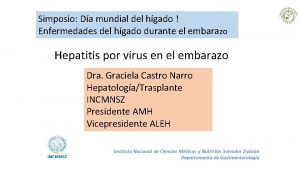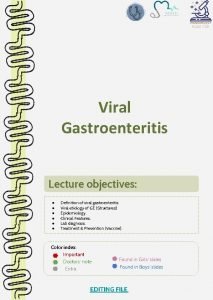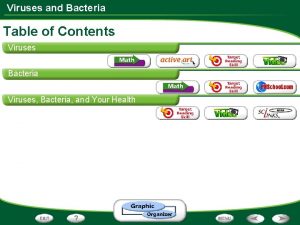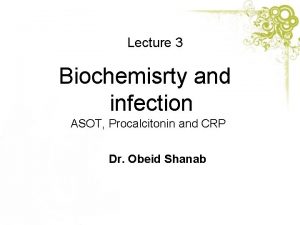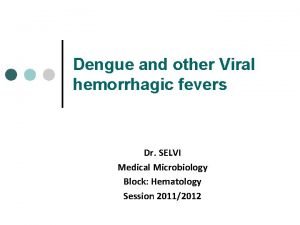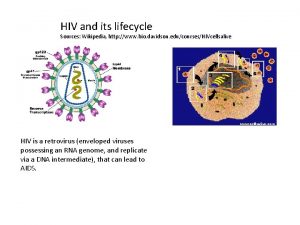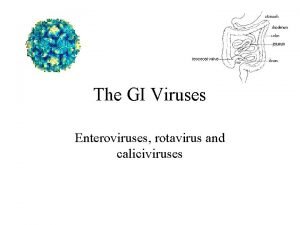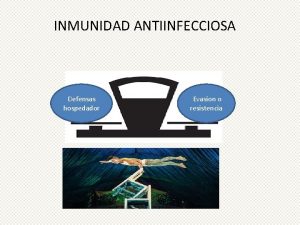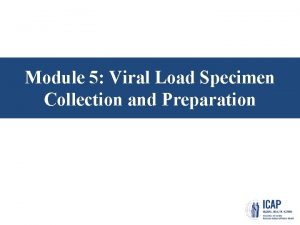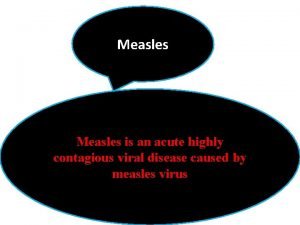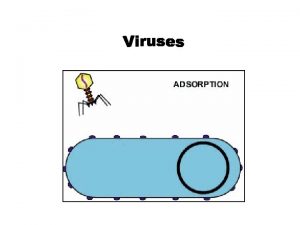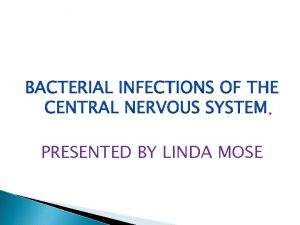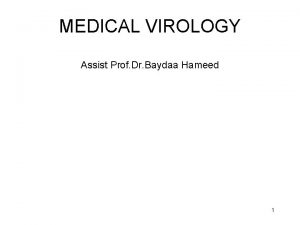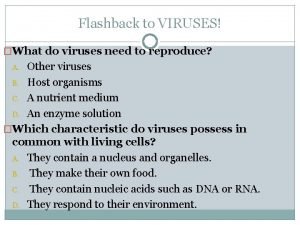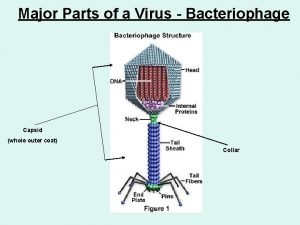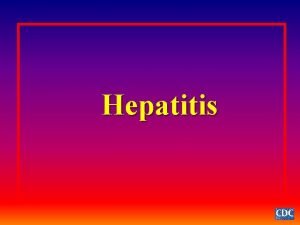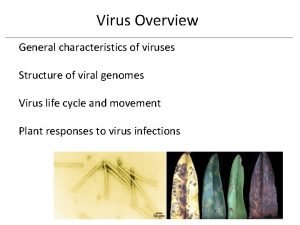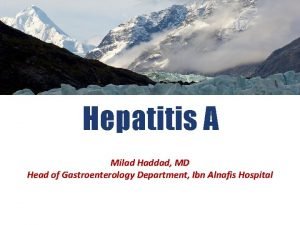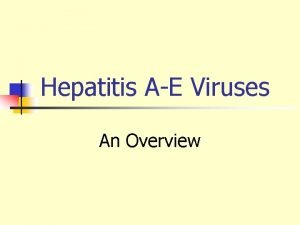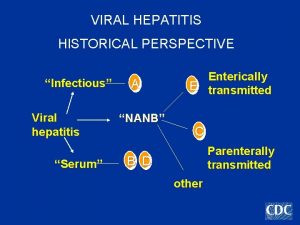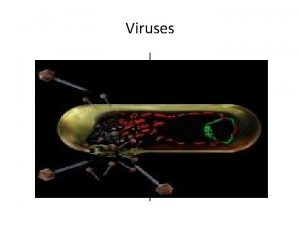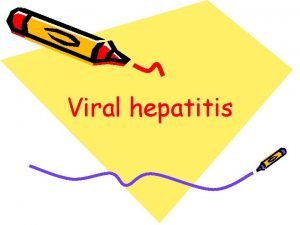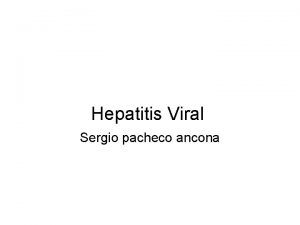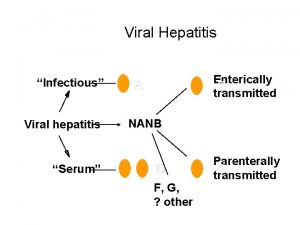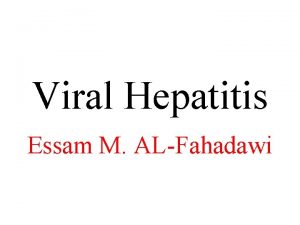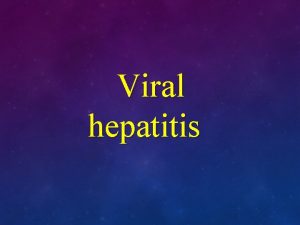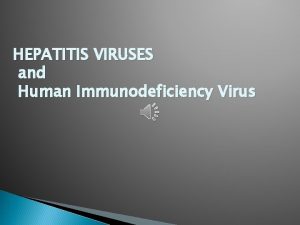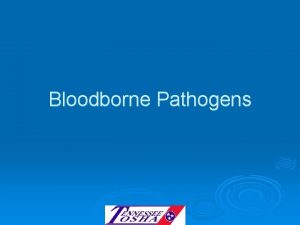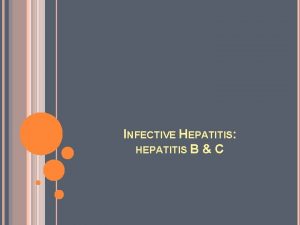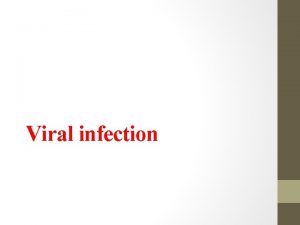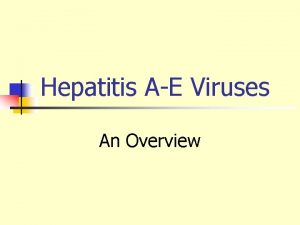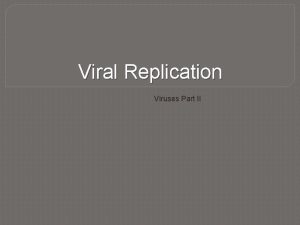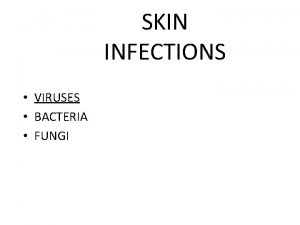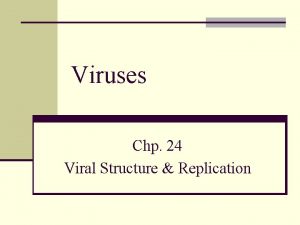Hepatitis AE Viruses An Overview Viral Hepatitis Historical
























































- Slides: 56

Hepatitis A-E Viruses An Overview

Viral Hepatitis - Historical Perspectives “Infectious” Viral hepatitis “Serum” Enterically E transmitted A NANB B D Parenterally C transmitted F, G, TTV ? other

Type of Hepatitis A Source of virus Route of transmission Chronic infection Prevention B C D E feces blood/ blood-derived body fluids feces fecal-oral percutaneous permucosal fecal-oral no yes pre/postexposure immunization yes blood donor pre/postscreening; exposure risk behavior immunization; modification risk behavior modification no ensure safe drinking water

Hepatitis A Virus

Hepatitis A Virus n n n Naked RNA virus Related to enteroviruses, formerly known as enterovirus 72, now put in its own family: heptovirus One stable serotype only Difficult to grow in cell culture: primary marmoset cell culture and also in vivo in chimpanzees and marmosets 4 genotypes exist, but in practice most of them are group 1

Hepatitis A - Clinical Features n n Incubation period: Jaundice by age group: n Complications: n Chronic sequelae: Average 30 days Range 15 -50 days <6 yrs, <10% 6 -14 yrs, 40%-50% >14 yrs, 70%-80% Fulminant hepatitis Cholestatic hepatitis Relapsing hepatitis None

Hepatitis A Infection Typical Serological Course Total anti. HAV Symptoms Titre ALT Fecal HAV 0 1 Ig. M anti-HAV 2 3 4 5 6 Months after exposure 1 2 2 4

Hepatitis A Virus Transmission n Close personal contact (e. g. , household contact, sex contact, child day care centers) Contaminated food, water (e. g. , infected food handlers, raw shellfish) Blood exposure (rare) (e. g. , injecting drug use, transfusion)

Global Patterns of Hepatitis A Virus Transmission Disease Peak Age Endemicity Rate of Infection High Transmission Patterns Low to High Early childhood Person to person; outbreaks uncommon Moderate High Late childhood/ young adults Person to person; food and waterborne outbreaks Low Very low Young adults Person to person; food and waterborne outbreaks Very low Adults Travelers; outbreaks uncommon


Laboratory Diagnosis n n Acute infection is diagnosed by the detection of HAV-Ig. M in serum by EIA. Past Infection i. e. immunity is determined by the detection of HAV-Ig. G by EIA. Cell culture – difficult and take up to 4 weeks, not routinely performed Direct Detection – EM, RT-PCR of faeces. Can detect illness earlier than serology but rarely performed.

Hepatitis A Vaccination Strategies Epidemiologic Considerations n n Many cases occur in community-wide outbreaks n no risk factor identified for most cases n highest attack rates in 5 -14 year olds n children serve as reservoir of infection Persons at increased risk of infection n travelers n homosexual men n injecting drug users

Hepatitis A Prevention - Immune Globulin n Pre-exposure n n travelers to intermediate HAV-endemic regions and high Post-exposure (within 14 days) Routine n household and other intimate contacts Selected situations n institutions (e. g. , day care centers) n common source exposure (e. g. , food prepared by infected food handler)

Hepatitis A Vaccine n n n Hepatitis A vaccine is an inactivated (killed) vaccine. 2 Doses are needed that are given at least 6 months apart. It can be considered for n n n those traveling to countries where hepatitis A is common, Homosexuals Drug Abusers have a chronic liver disease such as hepatitis B or hepatitis C are being treated with clotting-factor concentrates

Hepatitis B Virus

Hepatitis B Virus - Virology n n n Double stranded DNA virus, the + strand not complete Replication involves a reverse transcriptase. Complete Dane particle 42 nm, 28 nm electron dense core, containing HBc. Ag and HBe. Ag. The coat and the 22 nm free particles contain HBs. Ag At least 4 phenotypes of HBs. Ag are recognized; adw, adr, ayw and ayr. The HBc. Ag is of a single serotype Hepatitis B virus (HBV) has been classified into 8 genotypes (A-H). n n n Genotypes A and C predominate in the US. However, genotypes B and D are also present in the US. Genotype F predominates in South America and in Alaska, while A, D and E predominate in Africa. Genotype D predominates in Russia and in all its prior dominions, while in Asia, genotypes B and C predominate. Available data suggests that genotype produces a milder disease, respond better to IFN therapy, and is less likely to develop hepatocellular carcinoma. It has not in cell culture. yet been possible to propagate the virus

Hepatitis B - Clinical Features § Incubation period: § Clinical illness (jaundice): § Acute case-fatality rate: § Chronic infection: § Premature mortality from chronic liver disease: Average 60 -90 days Range 45 -180 days <5 yrs, <10% 5 yrs, 30%-50% 0. 5%-1% <5 yrs, 30%-90% 5 yrs, 2%-10% 15%-25%

Spectrum of Chronic Hepatitis B Diseases 1 Chronic Persistent asymptomatic Hepatitis - 2. Chronic Active Hepatitis symptomatic exacerbations of hepatitis 3. Cirrhosis of Liver 4. Hepatocellular Carcinoma

Acute Hepatitis B Virus Infection with Recovery Typical Serologic Course Symptoms HBe. Ag anti-HBe Total anti-HBc Titre 0 4 anti-HBs Ig. M anti-HBc HBs. Ag 8 12 16 20 24 28 32 36 Weeks after Exposure 52 100

Progression to Chronic Hepatitis B Virus Infection Typical Serologic Course Acute (6 months) Chronic (Years) HBe. Ag anti-HBe HBs. Ag Total anti-HBc Titre Ig. M anti-HBc 0 4 8 12 16 20 24 28 32 36 52 Weeks after Exposure Years

80 80 60 40 100 Chronic Infection 60 40 Chronic Infection (%) 20 20 Symptomatic Infection 0 Birth 1 -6 months 7 -12 months Age at Infection 1 -4 years 0 Older Children and Adults Symptomatic Infection (%) Chronic Infection (%) Outcome of Hepatitis B Virus Infection by Age at Infection 100

Global Patterns of Chronic HBV Infection n High (>8%): 45% of global population n Intermediate (2%-7%): 43% of global population n lifetime risk of infection >60% early childhood infections common lifetime risk of infection 20%-60% infections occur in all age groups Low (<2%): 12% of global population n n lifetime risk of infection <20% most infections occur in adult risk groups


Concentration of Hepatitis B Virus in Various Body Fluids High Moderate blood serum wound exudates semen vaginal fluid saliva Low/Not Detectable urine feces sweat tears breastmilk

Hepatitis B Virus Modes of Transmission § Sexual - sex workers and homosexuals are particular at risk. § Parenteral - IVDA, Health Workers are at increased risk. § Perinatal - Mothers who are HBe. Ag positive are much more likely to transmit to their offspring than those who are not. Perinatal transmission is the main means of transmission in high prevalence populations.

Diagnosis n n n n A battery of serological tests are used for the diagnosis of acute and chronic hepatitis B infection. HBs. Ag - used as a general marker of infection. HBs. Ab - used to document recovery and/or immunity to HBV infection. anti-HBc Ig. M - marker of acute infection. anti-HBc. Ig. G - past or chronic infection. HBe. Ag - indicates active replication of virus and therefore infectiveness. Anti-Hbe - virus no longer replicating. However, the patient can still be positive for HBs. Ag which is made by integrated HBV-DNA - indicates active replication of virus, more accurate than HBe. Ag especially in cases of escape mutants. Used mainly for monitoring response to therapy.

Treatment n n n Interferon - for HBe. Ag +ve carriers with chronic active hepatitis. Response rate is 30 to 40%. n alpha-interferon 2 b (original) n alpha-interferon 2 a (newer, claims to be more efficacious and efficient) Lamivudine - a nucleoside analogue reverse transcriptase inhibitor. Well tolerated, most patients will respond favorably. However, tendency to relapse on cessation of treatment. Another problem is the rapid emergence of drug resistance. Adefovir – less likely to develop resistance than Lamivudine and may be used to treat Lamivudine resistance HBV. However more expensive and toxic Entecavir – most powerful antiviral known, similar to Adefovir Successful response to treatment will result in the disappearance of HBs. Ag, HBV-DNA, and seroconversion to HBe. Ag. Telbivudine (Tyzeka, Sebivo) Approved in October 2006 by the FDA for adults. Several clinical trials have reported it to be more effective than lamivudine and adefovir.

Prevention n Vaccination - highly effective recombinant vaccines are now available. Vaccine can be given to those who are at increased risk of HBV infection such as health care workers. It is also given routinely to neonates as universal vaccination in many countries. Hepatitis B Immunoglobulin - HBIG may be used to protect persons who are exposed to hepatitis B. It is particular efficacious within 48 hours of the incident. It may also be given to neonates who are at increased risk of contracting hepatitis B i. e. whose mothers are HBs. Ag and HBe. Ag positive. Other measures - screening of blood donors, blood and body fluid precautions.

Hepatitis C Virus capsid envelop e protein c 22 protease/helica se 33 c RNA- RNA polymerase dependent c-100 5’ 3’ cor E 1 e E 2 hypervariable region NS 2 NS 3 NS 4 NS 5

Hepatitis C Virus < < < Genome resembled that of a positive stranded RNA genome of around 10, 000 bases flavivirus 1 single reading frame, structural genes at the 5' end, the non-structural genes at the 3' end. enveloped virus, virion thought to 30 -60 nm in diameter morphological structure remains unknown HCV has been classified into a total of six genotypes (type 1 to 6) on the basis of phylogenetic analysis < Genotype 1 and 4 has a poorer prognosis and response to interferon therapy, < In Hong Kong, genotype 1 accounts for around 67% of cases and genotype 6 around 25%. <

Terminology Family Genus Species Genotype Subtype Quasispecies

Hepatitis C - Clinical Features Incubation period: Average 6 -7 wks Range 2 -26 wks Clinical illness (jaundice): 30 -40% (20 -30%) Chronic hepatitis: 70% Persistent infection: 85 -100% Immunity: No protective antibody response identified

Chronic Hepatitis C Infection n n The spectrum of chronic hepatitis C infection is essentially the same as chronic hepatitis B infection. All the manifestations of chronic hepatitis B infection may be seen, albeit with a lower frequency i. e. chronic persistent hepatitis, chronic active hepatitis, cirrhosis, and hepatocellular carcinoma.

Hepatitis C Virus Infection Typical Serologic Course anti. HCV Symptoms Titre ALT Normal 0 1 2 3 4 5 6 Month s Time after Exposure 1 2 3 Years 4

Risk Factors Associated with Transmission of HCV § Transfusion or transplant from infected donor § Injecting drug use § Hemodialysis (yrs on treatment) § Accidental injuries with needles/sharps § Sexual/household exposure to anti-HCV-positive contact § Multiple sex partners § Birth to HCV-infected mother


Laboratory Diagnosis n n n HCV antibody - generally used to diagnose hepatitis C infection. Not useful in the acute phase as it takes at least 4 weeks after infection before antibody appears. HCV-RNA - various techniques are available e. g. PCR and branched DNA. May be used to diagnose HCV infection in the acute phase. However, its main use is in monitoring the response to antiviral therapy. HCV-antigen - an EIA for HCV antigen is available. It is used in the same capacity as HCV-RNA tests but is much easier to carry out.

Prognostic Tests n Genotyping – genotype 1 and 4 have a worse prognosis overall and respond poorly to interferon therapy. A number of commercial and inhouse assays are available. n n n Genotypic methods – DNA sequencing, PCR-hybridization e. g. INNOLIPA. Serotyping – particularly useful when the patient does not have detectable RNA. Viral Load – patients with high viral load are thought to have a poorer prognosis. Viral load is also used for monitoring response to IFN therapy. A number of commercial and in-house tests are available.

Treatment n n Interferon - may be considered for patients with chronic active hepatitis. The response rate is around 50% but 50% of responders will relapse upon withdrawal of treatment. Ribavirin - there is less experience with ribavirin than interferon. However, recent studies suggest that a combination of interferon and ribavirin is more effective than interferon alone. Protease inhibitors - The first protease inhibitors licensed were boceprevir (Victrelis) and telaprevir. They have been superseded by newer drugs such as Simeprevir (Olysio) and sofosbuvir (Sovaldi). In 2014, the FDA approved the combination of ombitasvir/paritaprevir/ritonavir and dasabuvir (Viekira Pak ) for the treatment of genotype 1 chronic hepatitis C infection in adults.

Prevention of Hepatitis C § Screening of blood, organ, tissue donors § High-risk behavior modification § Blood and body fluid precautions

Hepatitis D (Delta) Virus antigen HBs. Ag RNA

Hepatitis D Virus n n n The delta agent is a defective virus which shows similarities with the viroids in plants. The agent consists of a particle 35 nm in diameter consisting of the delta antigen surrounded by an outer coat of HBs. Ag. The genome of the virus is very small and consists of a single-stranded RNA

Hepatitis D - Clinical Features § Coinfection – severe acute disease. – low risk of chronic infection. § Superinfection – usually develop chronic HDV infection. – high risk of severe chronic liver disease. – may present as an acute hepatitis.

Hepatitis D Virus Modes of Transmission § Percutanous exposures § injecting drug use § Permucosal exposures § sex contact

HBV - HDV Coinfection Typical Serologic Course Symptoms ALT Elevated Titre anti-HBs Ig. M anti-HDV RNA HBs. Ag Time after Exposure Total anti-HDV

HBV - HDV Coinfection Typical Serologic Course Symptoms ALT Elevated Titre anti-HBs Ig. M anti-HDV RNA HBs. Ag Total anti-HDV Time after Exposure

HBV - HDV Superinfection Typical Serologic Course Jaundice Symptoms Titre Total anti-HDV ALT HDV RNA HBs. Ag Ig. M anti-HDV Time after


Hepatitis D - Prevention n HBV-HDV Coinfection Pre or postexposure prophylaxis to prevent HBV infection. n HBV-HDV Superinfection Education to reduce risk behaviors among persons with chronic HBV infection.

Hepatitis E Virus

Hepatitis E Virus n n n now classified as a member of the genus Orthohepevirus in the Hepeviridae family unenveloped RNA virus, 32 -34 nm in diameter +ve stranded RNA genome, 7. 6 kb in size. 4 genotypes: genotype 1 (Asia), genotype 2 (Africa and Mexico), genotype 3 (Europe and North America) and genotype 4 (Asia) very labile and sensitive Can only be cultured recently

Hepatitis E - Clinical Features n Incubation period: n Case-fatality rate: Average 40 days Range 15 -60 days Overall, 1%-3% Pregnant women, 15%-25% n Illness severity: Increased with age n Chronic sequelae: None identified

Hepatitis E Virus Infection Typical Serologic Course Symptoms Ig. G anti-HEV ALT Titer Ig. M anti-HEV Virus in stool 0 1 2 3 4 5 6 7 8 9 Weeks after Exposure 1 0 1 1 1 2 1 3

Hepatitis E Epidemiologic Features n n Most outbreaks associated with faecally contaminated drinking water. Several other large epidemics have occurred since in the Indian subcontinent and the USSR, China, Africa and Mexico. In the United States and other nonendemic areas, where outbreaks of hepatitis E have not been documented to occur, a low prevalence of anti-HEV (<2%) has been found in healthy populations. The source of infection for these persons is unknown. Minimal person-to-person transmission.


Prevention and Control Measures for Travelers to HEV-Endemic Regions n n Avoid drinking water (and beverages with ice) of unknown purity, uncooked shellfish, and uncooked fruit/vegetables not peeled or prepared by traveler. IG prepared from donors in Western countries does not prevent infection. Unknown efficacy of IG prepared from donors in endemic areas. . A recombinant vaccine called HEV 239 has been developed and is licensed for use in China.
 Unlike lytic viruses, lysogenic viruses do not
Unlike lytic viruses, lysogenic viruses do not Https://m..com/watch?v=nqecciuc7jy
Https://m..com/watch?v=nqecciuc7jy Hepatitis viral
Hepatitis viral Vrus
Vrus Andrew lippman mit
Andrew lippman mit Rotarix live attenuated
Rotarix live attenuated Viral
Viral Viral inoculation in embryonated egg
Viral inoculation in embryonated egg Mobilivirus
Mobilivirus Viral arthritis
Viral arthritis Streptococcus
Streptococcus Causes of viral hemorrhagic fever
Causes of viral hemorrhagic fever Morfologia viral
Morfologia viral Section 24-1 viral structure and replication
Section 24-1 viral structure and replication Viral integration
Viral integration Viral entry
Viral entry Viral recombination
Viral recombination Egg inoculation diagram
Egg inoculation diagram Viral shedding
Viral shedding Equine synonym
Equine synonym Inmunidad
Inmunidad Sample rejection criteria
Sample rejection criteria Inklüzyon cisimcikleri
Inklüzyon cisimcikleri Vacinas subcutânea
Vacinas subcutânea An acute highly contagious viral disease
An acute highly contagious viral disease The dynamics of viral marketing
The dynamics of viral marketing Vaccins à vecteur viral
Vaccins à vecteur viral Spasmodic croup
Spasmodic croup Aerochamber definition
Aerochamber definition Eline's viral
Eline's viral Viral dna
Viral dna Capsid capsomere
Capsid capsomere Tratamiento meningitis viral
Tratamiento meningitis viral Viral inoculation in embryonated egg
Viral inoculation in embryonated egg Viral life cycle
Viral life cycle Bacterial vs viral vs fungal meningitis csf
Bacterial vs viral vs fungal meningitis csf Viral receptors
Viral receptors Varicela variola
Varicela variola Egrette chapter 21
Egrette chapter 21 Lysogenic viruses do not
Lysogenic viruses do not Parts of the virus
Parts of the virus Basic properties of viruses
Basic properties of viruses Best viruses
Best viruses Hepatotropic viruses
Hepatotropic viruses Are viruses alive yes or no
Are viruses alive yes or no Smallest infectious agent
Smallest infectious agent Bacteriophage characteristics
Bacteriophage characteristics General properties of viruses
General properties of viruses Importance of viruses
Importance of viruses Biosynthesis of rna viruses
Biosynthesis of rna viruses Nonliving particle that replicates inside a living cell
Nonliving particle that replicates inside a living cell Section 19-3 diseases caused by bacteria and viruses
Section 19-3 diseases caused by bacteria and viruses Baltimore classification
Baltimore classification Charateristics of viruses
Charateristics of viruses Viruses video
Viruses video Chapter 18 section 2 viruses and prions
Chapter 18 section 2 viruses and prions Hepatotropic viruses
Hepatotropic viruses


